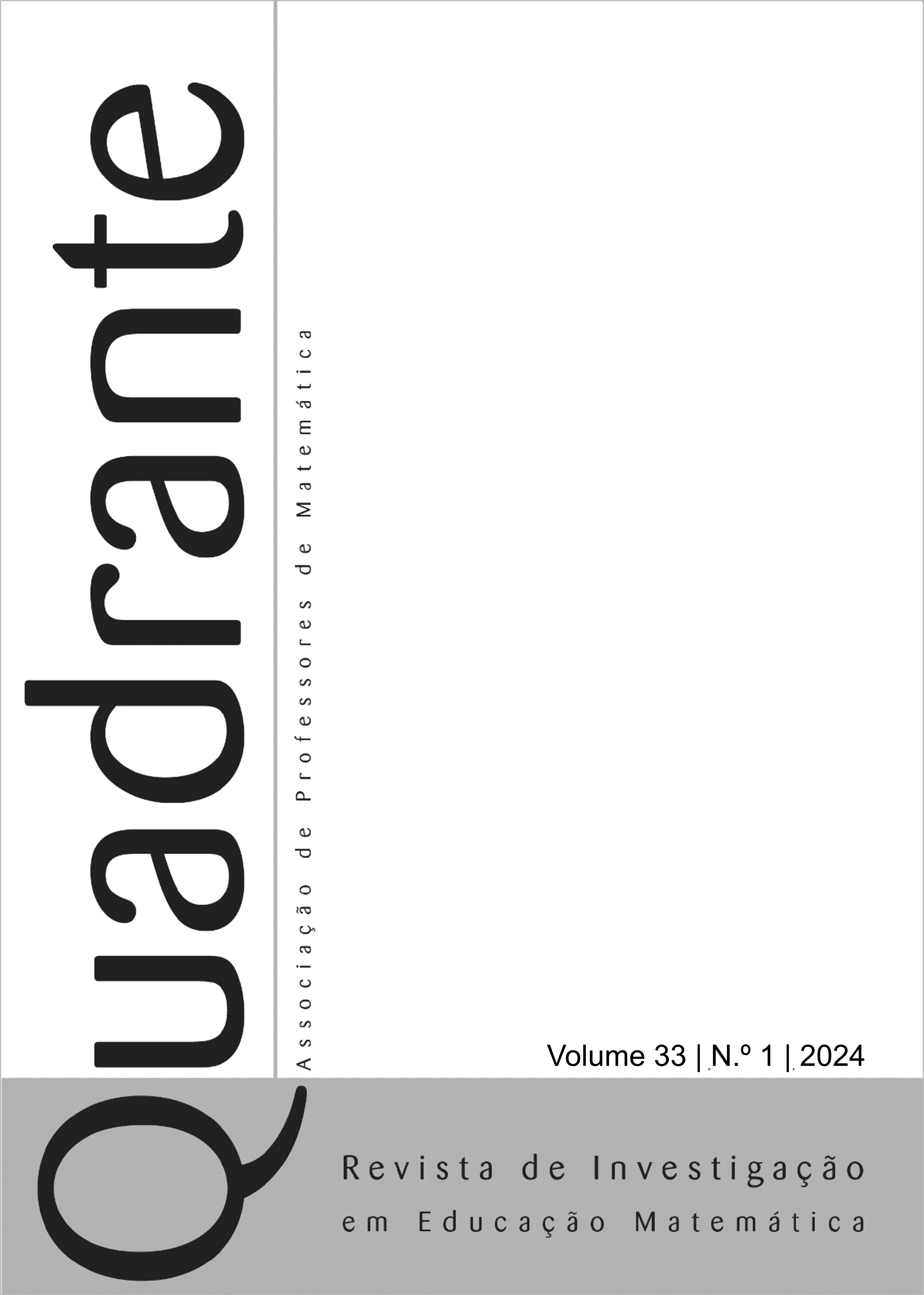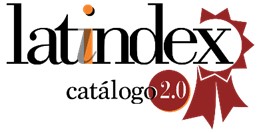Integration of technologies in the First Teaching Practice: The case of a preservice mathematics teacher
DOI:
https://doi.org/10.48489/quadrante.29721Keywords:
preservice teacher education, teaching practice, digital technologies, mathematics educationAbstract
This article reports an intrinsic case study in which we identify and characterize ways of significant integration of digital technologies by a female preservice mathematics teacher in the framework of her first teaching practice, carried out in a secondary school equipped with various technological resources. The integration of technologies is analyzed according to the framework called Structuring Features of Classroom Practice, following a qualitative methodology within the interpretative paradigm appealing to deductive and inductive categories. The results show that the significant integration of digital technologies by the preservice teacher was produced by putting into play a framework of actions related to: the adaptations registered in the work environment of the practice, the planned resources, and the various modes of interaction promoted in the classroom. The study provides contributions that allow reviewing and rethinking actions in teacher education programs related to the integration of digital technologies.
References
Alomar, B. R., Carreras, M. C., & Dipierri, I. C. (2013). Una experiencia con modelización matemática en el contexto escolar. [Bachelor’s thesis, Facultad de Matemática, Astronomía y Física - Universidad Nacional de Córdoba]. Repositorio Digital UNC. https://rdu.unc.edu.ar/handle/11086/550286
Bassanezi, R. C. (2012). Temas y modelos (1.ed.). Campinas, Brasil: UFABC.
Borba, M., & Penteado, M. (2001). Informática e Educação Matemática. Editora Autêntica.
Bozkurt, G., & Koyunkaya, M. Y. (2022). Using the Instrumental Orchestration Model for planning and teaching technology-based mathematical tasks as part of a restructured practicum course. In A. Clark-wilson, O. Robutti, & N. Sinclair (Eds.), The Mathematics Education in the Digital Era. International Research on Professional Learning and Practice (pp. 31–64). Springer Nature Switzerland AG. https://doi.org/10.1007/978-3-031-05254-5_2
Bozkurt, G., & Ruthven, K. (2015). Expert and novice teachers’ classroom practices in a technological environment. In K. Krainer & N. Vondrová (Eds.), CERME 9 - Ninth Congress of the European Society for Research in Mathematics Education (pp. 2319–2325). Charles University in Prague, Faculty of Education.
Bozkurt, G., & Ruthven, K. (2017). Classroom-based professional expertise: a mathematics teacher’s practice with technology. Educational Studies in Mathematics, 94, 309–328. https://doi.org/10.1007/s10649-016-9732-5
Carmona-Mesa, J. A., Flores Salazar, J. V., & Villa-Ochoa, J. A. (2018). Uso de calculadoras simples y videojuegos en un curso de formación de profesores. Uni-Pluriversidad, 18(1), 13–24. https://doi.org/10.17533/udea.unipluri.18.1.02
Carmona-Mesa, J. A., González-Gómez, D., & Villa-Ochoa, J. A. (2020). Autoeficacia de Profesores en Formación Inicial en el Uso de Tecnología para Enseñar Matemáticas. Boletim de Educação Matemática, 34(67), 583–603.
Carmona-Mesa, J. A., & Villa-Ochoa, J. A. (2017). Necesidades De Formación En Futuros Profesores Para El Uso De Tecnologías. Resultados De Un Estudio Documental. Revista Paradigma, 38(1), 169–185.
Clark-Wilson, A., Oldknow, A., & Sutherland, R. (2011). Digital Technologies and Mathematics Education. Joint Mathematical Council of the United Kingdom.
Clark-Wilson, A., Robutti, O., & Sinclair, N. (2022). The Mathematics Education in the Digital Era. International Research on Professional Learning and Practice (Second Edi). Springer Nature Switzerland AG.
Clark-Wilson, A., Robutti, O., & Thomas, M. (2020). Teaching with digital technology. ZDM– Mathematics Education, 52(7), 1223–1242. https://doi.org/10.1007/s11858-020-01196-0
Denzin, N. K., & Lincoln, Y. S. (2017). The SAGE Handbook of Qualitative Research. SAGE Publications.
Drijvers, P., Doorman, M., Boon, P., Reed, H., & Gravemeijer, K. (2010). The teacher and the tool: Instrumental orchestrations in the technology-rich mathematics classroom. Educational Studies in Mathematics, 75(2), 213–234. https://doi.org/10.1007/s10649-010-9254-5
Drijvers, P., Tacoma, S., Besamusca, A., Doorman, M., & Boon, P. (2013). Digital resources inviting changes in mid-adopting teachers’ practices and orchestrations. ZDM–The International Journal on Mathematics Education, 45, 987–1001. https://doi.org/10.1007/s11858-013-0535-1
Figueiredo, F. F., & Groenwald, C. L. O. (2020). Design, (re)formulação e resolução de problemas com o uso de tecnologias digitais na formação inicial de professores de matemática. Revista Latinoamericana de Investigacion En Matematica Educativa, 23(2), 147–174. https://doi.org/10.12802/relime.20.2321
Fraser, V., Garofalo, J., & Juersivich, N. (2011). Enhancing lesson planning and quality of classroom life: A study of mathematics student teachers ’ use of technology. Journal of Technology and Teacher Education, 19(2), 169–188.
Huang, R., & Zbiek, R. M. (2017). Prospective secondary mathematics teacher preparation and technology. In M. E. Strutchens, L. Losano, J. P. da Ponte, M. C. Cyrino, R. M. Zbiek, R. Huang, & D. Potari (Eds.), The Mathematics Education of Prospective Secondary Teachers Around the World, ICME-13 Topical Surveys (pp. 17–23). Springer Nature. https://doi.org/10.1007/978-3-319-38965-3_3
Instituto Nacional de Formación Docente (2016). Plan Nacional de Formación Docente 2016-2021. Ministerio de Educación y Deportes Presidencia de la Nación. http://www.bnm.me.gov.ar/giga1/documentos/EL005991.pdf
Losano, L., Fiorentini, D., & Villarreal, M. (2018). The development of a mathematics teacher’s professional identity during her first year teaching. Journal of Mathematics Teacher Education, 21, 287-315. https://doi.org/10.1007/s10857-017-9364-4
Mántica, A. M., & Freyre, M. L. (2019). Análisis de la relación entre imagen y definición en una situación problemática mediada por GeoGebra a partir de no ejemplos del concepto de poliedro regular. Educacion Matematica, 31(1), 204–234. https://doi.org/10.24844/EM3101.08
Meagher, M., Ozgun-Koca, S., & Edwards, M. T. (2011). Preservice teachers’ experiences with advanced digital technologies: The interplay between technology in a preservice classroom and in field placements. Contemporary Issues in Technology & Teacher Education, 11, 243–270.
Ministerio de Educación (2010). Proyecto de mejora para la formación inicial de profesores para el nivel secundario. Áreas: Biología, Física, Matemática y Química. https://cedoc.infd.edu.ar/wp-content/uploads/2020/01/Matematica.pdf
Ministerio de Educación (2011). Diseño Curricular para el Ciclo Básico 2011-2015. https://www.igualdadycalidadcba.gov.ar/SIPEC-CBA/publicaciones/EducacionSecundaria/LISTO%20PDF/TOMO%202%20Ciclo%20Basico%20de%20la%20Educacion%20Secundaria%20web%208-2-11.pdf
Ministerio de Educación (2015). Diseño Curricular para el Profesorado de Educación Secundaria en Matemática. https://dges-cba.infd.edu.ar/sitio/curriculares/upload/DISENIO_CURRICULAR_MATEMATICA__2010.pdf
Olive, J., & Leatham, K. (2000). Using technology as a learning tool is not enough. In M. J. Thomas (Ed.), Proceedings of the International Conference on Technology in Mathematics Education (pp. 236–243). The University of Auckland and Auckland University of Technology.
Phillips, E., Gardella, T., Kelly, C., & Stewart, J. (1993). Patterns and functions: Curriculum and evaluation standards for school mathematics addenda series, grades 5–8. National Council of Teachers of Mathematics.
Rocha, H. (2020). Using tasks to develop pre-service teachers’ knowledge for teaching mathematics with digital technology. ZDM - Mathematics Education, 52(7). https://doi.org/10.1007/s11858-020-01195-1
Ruthven, K. (2009). Towards a naturalistic conceptualisation of technology integration in class-room practice: The example of school mathematics. Éducation Et Didactique, 3(1), 133–152.
Ruthven, K. (2014). Frameworks for Analysing the Expertise That Underpins Successful Integration of Digital Technologies into Everyday Teaching Practice. In A. Clark-Wilson, O. Robutti, & N. Sinclair (Eds.), The Mathematics Teacher in the Digital Era (Vol. 2, pp. 373–393). Springer Netherlands. https://doi.org/10.1007/978-94-007-4638-1_16
Stake, R. E. (1999). Investigación con estudio de casos (2da ed.). Ediciones Morata S.L.
Strutchens, M., Huang, R., Losano, L., Portari, D., Ponte, J. P., Cyrino, M. C., & Zbiek, R. M. (2017). The mathematics education of prospective secondary teachers around the world. Springer Nature. https://doi.org/10.1007/978-3-319-38965-3
Turgut, M. (2019). Sense-making regarding matrix representation of geometric transformations in R2: a semiotic mediation perspective in a dynamic geometry environment. ZDM - Mathematics Education, 51(7). https://doi.org/10.1007/s11858-019-01032-0
Villarreal, M. E., & Esteley, C. B. (2022). Researching professional trajectories regarding the integration of digital technologies: The case of Vera, a novice mathematics teacher. In A. Clark-Wilson, O. Robutti, & N. Sinclair (Eds.), The mathematics teacher in the digital era. International research on professional learning and practice (pp. 323-346). Springer. https://doi.org/10.1007/978-3-031-05254-5_12
Villarreal, M. E., Esteley, C. B., & Smith, S. (2018). Pre-service teachers’ experiences within modelling scenarios enriched by digital technologies. ZDM - Mathematics Education, 50, 327-341. https://doi.org/10.1007/s11858-018-0925-5
Zengin, Y. (2018). Examination of the constructed dynamic bridge between the concepts of differential and derivative with the integration of GeoGebra and the ACODESA method. Educational Studies in Mathematics, 99(3). https://doi.org/10.1007/s10649-018-9832-5











